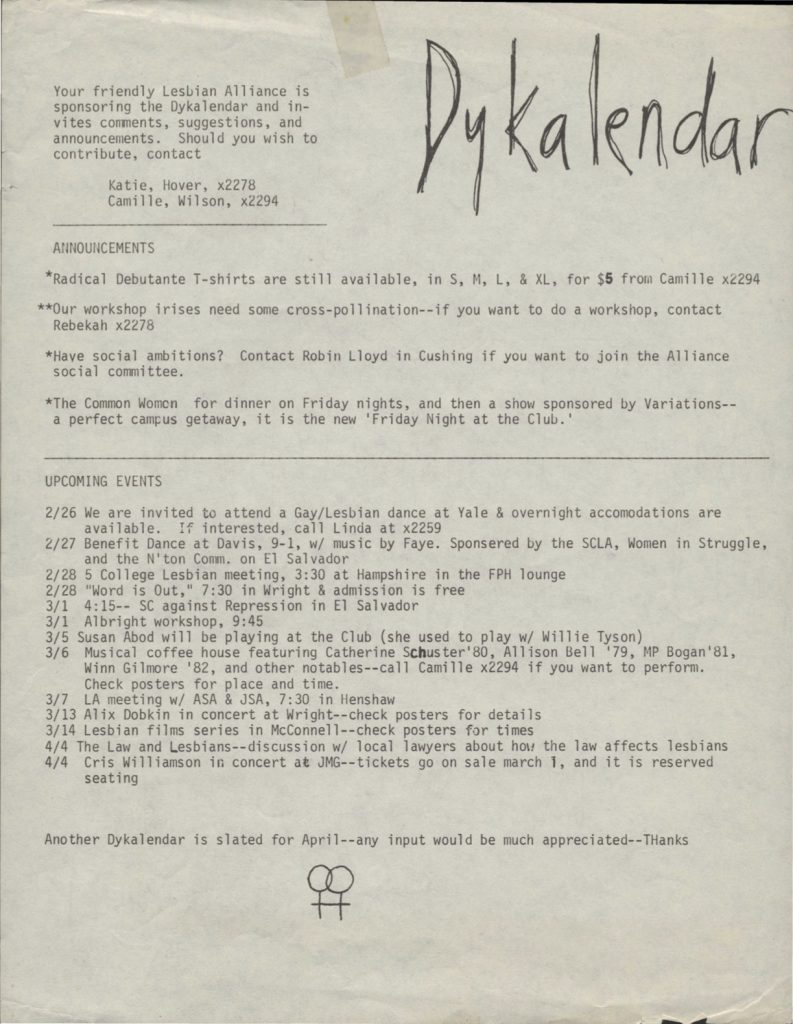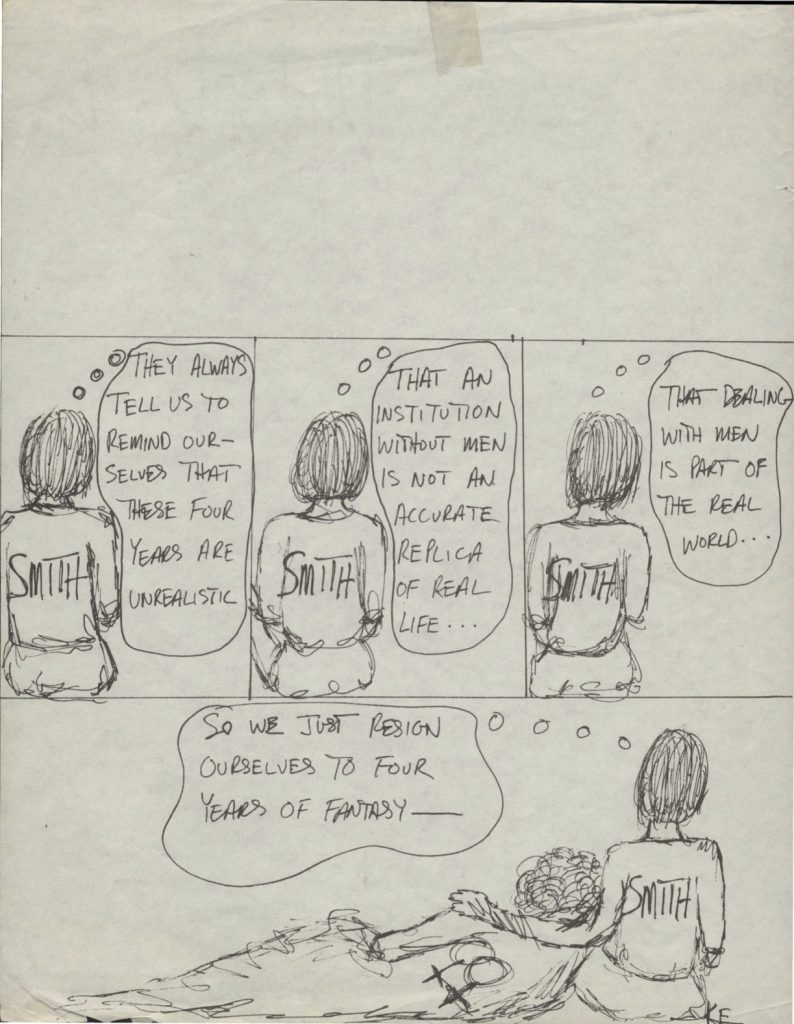The Smith College Lesbian Alliance has its roots in a different organization, “Sophia’s Sisters.” According to a student paper about the history of the Alliance, Smith College sponsored a “women’s weekend” in the spring of 1973. By the end of that event, 90% of the women had “come out,” leading a group of the women to organize a small support and social group of lesbian and bisexual women called “Sophia’s Sisters.” 1 Unable to get chartered, the organization fizzled out by 1975 as the founders graduated. However, in 1976, a student wrote a public letter to the college newspaper, The Sophian, complaining of “blatant and obvious” homosexual displays of affection. 2 Frustrated by this article and harassment and misunderstanding on campus, a group of Smith Students founded the Smith College Lesbian Alliance in 1976. Their primary goals were to establish a network of support for lesbians on campus and to educate the student body about issues of lesbianism, alleviating the day-to-day tension between lesbians and straight students. 3 In their first years, the organization struggled to assert themselves; originally they were denied funding from Student Government Association and had to fight for formal recognition from the college. By 1979, the Lesbian Alliance had been officially recognized and funded, and their first major project was running a series of informative workshops for head residents about lesbianism. 4
In the early 1980s, the period in which the Lesbian Alliance Survey was conducted, the organization focused on visibility of lesbians on campus. As one leader of the organization wrote, “Better blatant than latent.” 5 They sent out monthly newsletters, called “Dykalenders” with information about LGBT events on campus and in the community. The organization protested the closing of Hover House, a unofficial lesbian house on campus. You can read more about that in the “Hover House” tab of this website. The Lesbian Alliance also dealt with continual acts of homophobia and hate crimes on campus and pressed the college’s administration to work to better protect lesbian students. 6 The president of the organization from ‘81-’82 stated that it was important to her that the lesbian community at Smith integrated itself in the lesbian community in Northampton. 7 By the early 1980s, Northampton already had a reputation as being a lesbian town. The Lesbian Alliance hosted prominent lesbian speakers on campus and invited in the community. They also regularly attended events hosted in the community by local lesbian groups. 8 In the early 1980s, the alliance began the annual “Smith is For Lovers” picnic, and in the later 1980s, they began the tradition of holding a “radical debutante ball.” In 1989, the name of the organization was changed to the “Lesbian Bisexual Alliance” to be more inclusive. With discussions, workshops, dances, discussion groups, and sponsored panels, the Lesbian Alliance stayed active throughout the 1980s. 9




In the 1990s, the organization worked to become more inclusive to a wider range of LGBT people. They revived the old newsletter of the early 1980s and began new dances and social events. They maintained a Lesbian Alliance space on campus, including a library. By the 2000s, there were a variety of smaller groups within the organization including a group for women of color and a group for trans students. 10 The organization changed its name to the LGBT alliance, then to Spectrum. Overtime with changing national and college contexts, the organization petered out, and queer organizing became part of the more mainstream sections of the College. However, the Smith College Lesbian Alliance paved the way for the LGBT community that exists at Smith today.
Yearbooks
The presence of the Lesbian Alliance in Smith College’s yearbooks demonstrates the precarity of publicly displaying lesbianism in the 1980s and 90s. Although The Alliance was founded in 1976, it didn’t appear in the yearbook until 1982. In this year, all the other organizations in the yearbook included a picture of the organizations’ members, but in the space for the Lesbian Alliance, there was simply an image of a blurred-out crowd. The caption read, “Not pictured: Susan, Susan, Susan etc,” highlighting the perceived need for anonymity of the Alliance members. 11 The next year, there was a photo with about eleven members of the organization, but again in 1984, instead of a photo, a blank space was left where the organization’s photo would have gone. For years, drawings and photos of banners sat in place of an image of the Alliance. Only in the late 80s and early 90s were photos of the organization a consistent feature of the Smith College yearbook. However, sometimes only a few members were pictured. The Lesbian Alliance section of an early 1990s yearbook stated “We wish to acknowledge that not all members of the Lesbian Bisexual Alliance are able to appear in this picture because of the homophobic and heterosexist society in which we live. We are committed to working for a day in which it will no longer be uncomfortable or jeopardizing to come out in this yearbook or anywhere else.” The photos and their absences in the yearbook are particularly telling. What can we learn about lesbian history at Smith from the images in the yearbook? How safe is lesbian visibility on campus now?
All images in Smith College Yearbook Collection, Smith College Archives.
- The Lesbian Alliance: A Study of a Minority Group and Liberal Tolerance” by Susan Jessop, 1979, CA-MS-00112, Box 3016, Series II, Lesbian Bisexual Transgender Alliance Records, Smith College Archives, https://findingaids.smith.edu/repositories/4/resources/16/collection_organization, Page 3. ↩
- Ibid., Page 4. ↩
- Ibid., Pages 4-5. ↩
- Ibid., Pages 6-7. ↩
- “On the Year ’81-’82” by Linda McRoy, 1982, CA-MS-00112, Box 3016, Series II, Smith College Archives, Lesbian Bisexual Transgender Alliance Records. https://findingaids.smith.edu/repositories/4/resources/16/collection_organization, page 1. ↩
- Lesbian Bisexual Transgender Alliance Records, Box 3016, Series I, Folder 1-5, https://findingaids.smith.edu/repositories/4/resources/16/collection_organization ↩
- “On the Year ’81-’82” by Linda McRoy, 1982, CA-MS-00112, Box 3016, Series II, Smith College Archives, Lesbian Bisexual Transgender Alliance Records. https://findingaids.smith.edu/repositories/4/resources/16/collection_organization, ↩
- Susan E. McKenna, “Seeing Lesbian Queerly: Visibility, Community, and Audience in 1980s Northampton, Massachusetts” (University of Mass Amherst), accessed March 20, 2021, https://scholarworks.umass.edu/open_access_dissertations/102/. page 128. ↩
- Lesbian Bisexual Transgender Alliance Records, CA-MS-00112, Box 3016.1, Series III, Smith College Archives, https://findingaids.smith.edu/repositories/4/resources/16/collection_organization. ↩
- Lesbian Bisexual Transgender Alliance Records, Box 3016, Series 1, Smith College Archives, https://findingaids.smith.edu/repositories/4/resources/16/collection_organization. ↩
- 1982 Smith College Yearbook, Smith College Archives. ↩
